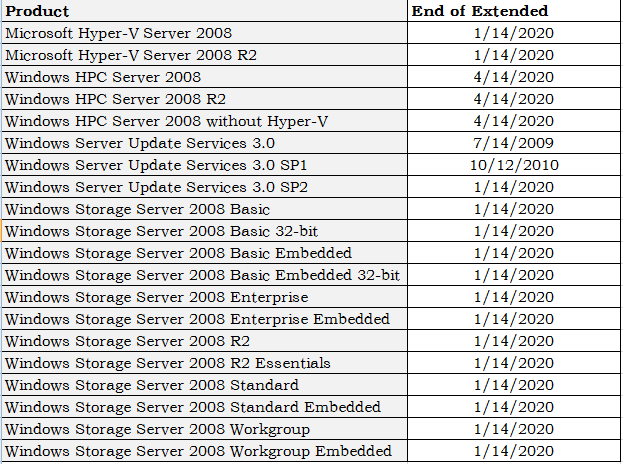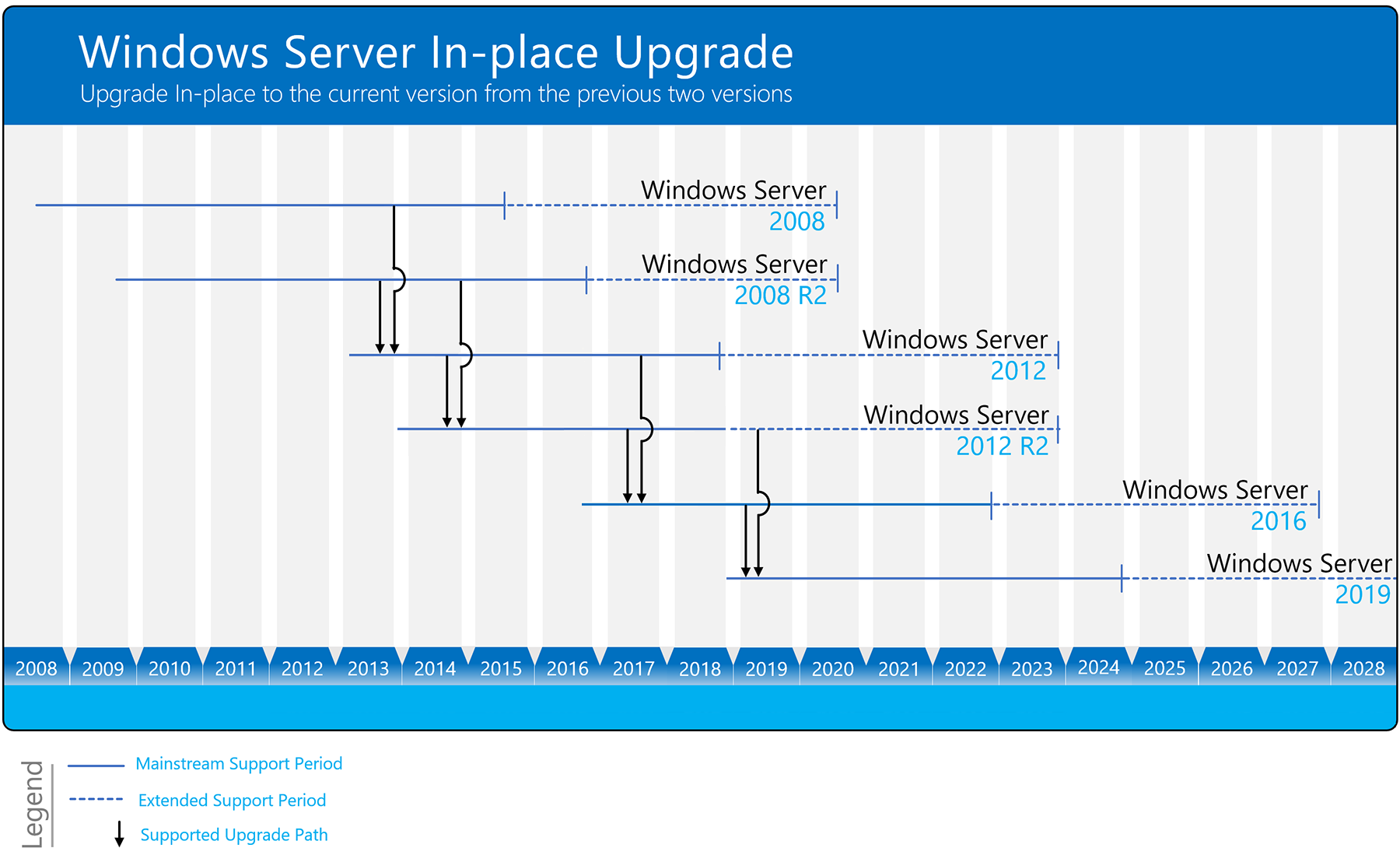Windows Server 2008 (R2) End of Life | What to Do Now?
Windows Server 2008 end-of-life date
Microsoft announces Windows Server 2008 (R2) end of life date once again. The first end of date would be Jan 13, 2015, also known as Mainstream Support end date. This time, the end of date is Jan 14, 2020, which is Extended Support end date.
The end of Mainstream Support means that Microsoft will no longer improve the product, accept warranty claims, or provide non-security hotfixes. While the end of Extended Security Updates means that bug fixes and security updates will no longer be available. Here is some information on Server 2008 (R2) Service Pack 1/2 lifecycle start and end dates.
In general, regular updates (free security updates on-premises, non-security updates, free support options, and online technical content updates) are not provided anymore, which indicates the real end of one operating system.
In fact, not only Windows Server 2008, some other systems have also been announced the end of active support and security support, you can click here to check.
- Potential risks come with Windows Server 2008(R2) end of life
- Windows Server 2008 end of life, can you get extended support?
- Recommended: Upgrade operating system to higher versions
- Precaution: Add protection for important data in Server 2008 (R2)
Potential risks come with Server 2008 R2 end of life
As mentioned earlier, from January 14, 2020, Microsoft will not provide any security updates and vulnerability patches, therefore your computer will be more vulnerable to security risks. EternalBlue and BlueKeep are 2 powerful vulnerabilities cyber criminals frequently exploited in recent years, which have led to huge data loss. WannaCry in 2017 is the most typical example.
In addition, there are some common risks you need to know:
1. Compliance issues
Many organizations need to follow the security rules to keep their equipment up to date regarding compliance. If you are still running Windows Server 2008(R2) past its expiration date, your business will no longer be compliant.
2. Increased operational costs
It's really expensive for an organization to maintain an outdated opersting system, except for the basic maintenance, you still need to do more to enhance its security. In addition, the outdated software on your computer will greatly increase the risk of spreading malware.
Windows Server 2008 end of life, can you get extended support?
Even though Microsoft has announced the end of Windows Server 2008(R2) Extended Support, you still have some ways to get extended support. But please note that this kind of extension is limited, and Microsoft recommends you upgrade to a newer version instead.
1. Pay for extended support
For enterprises, you could consider paying for an extended security update subscription to keep your server protected until you are ready to upgrade to a newer Windows Server version.
These updates are provided for up to three years after the end of support lifecycle date, which means the support is only available until 2023, at that time, it's the real end. Thus, you can use it as a transition solution, not a long-term plan.
2. Migrate to Microsoft Azure to extend security updates
Actually, Microsoft provides a way for Windows Server 2008 users to extend security updates. Here is a quotation from their technical website: "Customers who use Windows Server 2008 or Windows Server 2008 R2 products and services should migrate to Microsoft Azure to take advantage of 3 additional years of Critical and Important security updates at no additional charge and modernize when ready."
That is to say, you can get another 3 years of protection by migrating to Microsoft Azure. Nevertheless, not all products are qualified to the migration rule. Only products in the chart below are able to do the migration.
For more information, if you own one of the following products, you have to seek another way out since they are not eligible for the Extended Security Updates. These products are coming to their rear end. Don't worry, you may check out the next solution.
Recommended: Upgrade the operating system to higher versions
For users who own products that are not able to migrate to Microsoft Azure and who don't want to migrate to that service, one of acceptable solutions is to perform Windows Server In-place upgrade or clean install. You can upgrade the Windows Server 2008 (R2) operating system to higher editions, such as Server 2016 or the latest Server 2019, 2022.
Besides, you may need to do some infrastructure updates like drivers updating, physical hard drive upgrading, etc. eventually for better compatibility with the new operating system in the future.
Precaution: Add protection for important data in Server 2008 (R2)
No matter which method you prefer, the first thing you need to do is create protection for existing crucial data, especially the data of clients. Now that security updates are no longer available, we can't throw away data backups anymore. Two practical backup utilities will be recommended for different backup conditions.
For users who own one or two Windows 2008 Servers, Qiling Disk Master Server edition is recommended. This comprehensive software embeds with various backup and cloning options. In terms of Backup, you have System Backup, Disk Backup, File/Folder Backup, Partition Backup. Additional features would include schedule backup (daily, weekly, monthly, event-trigger, etc.) and backup scheme (incremental, differential, etc.).
You can grab the free trial now:
▶ It works with all Windows Server or Client systems, so even when you are running newer versions of Windows Server, like 2019 or 2022, you can still use it for data protection and migration.
▶ The cloning feature is quite help in upgrading hard drives. For example, you can clone Windows Server 2008 hard drive to the desired disk without reinstalling operating system. System Clone and Partition/Volume Clone are also available. You can also create bootable drive to backup or clone disk without Windows.
The bottom line
Windows Server 2008 (R2) end of life is unavoidable, but we can make some preparations to respond to it smartly. You can choose to pay for extended support, migrate to Azure, upgrade to higher versions after the end date, or keep using it without any further security updates or bug fixes. Yet it is strongly recommended to create backups for vital data on the server.
If you want to protect unlimited PCs & servers in your company, you may choose Qiling Disk Master Technician Plus. It offers unlimited billable technical services to clients. It also enables you to copy installation directory for portable version creation.
Related Articles
- Windows 7 End of Life Extended What to Do?
Windows 7 end of life extended what to do? You may have such a question, in which case it is important to first learn more about Windows 7 end of life and then get a clear idea of what to do. - Restore Windows Server 2008 R2 to Previous Date | 3 Ways
How to restore Windows Server 2008 R2 to previous date? If you are looking for a way to do it, pleas continue to see below and this article will introduce you to 3 effective methods. - How Do I Create System Image for Windows Server 2008(R2)?
Creating system image backup in Windows Server 2008 (R2) is essential to protect your system and data on it. With it, you can easily recover them without downtime in the event of a disaster. - Full Guide | Upgrade Windows Server 2012 R2 to 2019 Securely
To upgrade Windows Server 2012 r2 to 2019 on the same hardware and keep all the server roles and data intact, in-place upgrade is a good idea. Theoretically it shouldn't delete any of your data, but it's best to make a backup before upgrading just in case.





